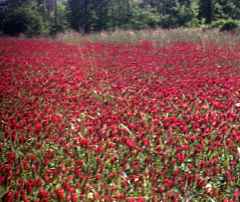Vol. 1 #7
August 11, 2000
Fall
Cover Crops
for
the Vegetable Garden
 This
week we will discuss cover crops for your garden. The function of
a "cover crop" is to prevent loss of soil and nutrients through erosion
on an area left barren due to a lack of crop in the fall and winter seasons.
The nutrients are taken up by the cover crop during its winter growth period
and returned to the soil through incorporation into the soil the following
spring. Additionally, the cover crop provides needed organic matter
to the soil when it is tilled into the soil in the spring. Organic
matter (previously living materials) is critical to healthy soil as the
breeding ground for micro-organisms needed in the life cycle of plants.
Cover crops are also referred to as "green manure".
This
week we will discuss cover crops for your garden. The function of
a "cover crop" is to prevent loss of soil and nutrients through erosion
on an area left barren due to a lack of crop in the fall and winter seasons.
The nutrients are taken up by the cover crop during its winter growth period
and returned to the soil through incorporation into the soil the following
spring. Additionally, the cover crop provides needed organic matter
to the soil when it is tilled into the soil in the spring. Organic
matter (previously living materials) is critical to healthy soil as the
breeding ground for micro-organisms needed in the life cycle of plants.
Cover crops are also referred to as "green manure".
A couple of weeks ago we spoke of turnips, kale, and mustard as fall crops,
all of which can also double as winter cover crops. Other crops include
crimson clover, hairy vetch, Austrian winter peas, grain rye, winter wheat,
and annual rye grass. The clover, vetch, and peas are legumes.
A legume is a plant harboring bacteria called Rhizobium which are
attached to the roots of the cover crop. These bacteria are capable
of collecting nitrogen from the atmosphere and storing in nodules developed
on the roots of the host plant. Nitrogen is a major element in plant
nutrition and this is a free source of nitrogen. Legumes should be
"turned in" to the soil at the point of blossom for maximum retention of
nutrients and organic matter.
Crimson
clover is an attractive winter annual with a deep red blossom reaching
a height of one to two feet. Hairy vetch is an excellent soil building
legume with a fuchsia blossom reaching a height of two to three feet.
Hairy vetch can be difficult to till into the soil due to its dense root
mat. Austrian Winter Peas are pea like legume reaching a height of
two to three feet. All three of these legumes should be seeded in
August and September at the rate of 20 to 30 pounds per acre (1 pound covers
1,000 to 2,000 square feet).
The small grains such as grain rye and wheat are not legume, but they make
great ground covers, and can be planted later in the fall because they
germinate at cooler temperatures. Small grains should be seeded from
September through early November at the rate of 60 to 120 pounds per acre
(2 to 3 pounds per 1,000 square feet). Annual rye grass resembles
turf grass, provides good cover for the winter, and should be seeded at
the same time as small grains but at the legume rate.
In March or April, mow the cover crops and then till the clippings and
the roots into the soil. You may begin planting two weeks after incorporation.
Andy Lynn
 This
week we will discuss cover crops for your garden. The function of
a "cover crop" is to prevent loss of soil and nutrients through erosion
on an area left barren due to a lack of crop in the fall and winter seasons.
The nutrients are taken up by the cover crop during its winter growth period
and returned to the soil through incorporation into the soil the following
spring. Additionally, the cover crop provides needed organic matter
to the soil when it is tilled into the soil in the spring. Organic
matter (previously living materials) is critical to healthy soil as the
breeding ground for micro-organisms needed in the life cycle of plants.
Cover crops are also referred to as "green manure".
This
week we will discuss cover crops for your garden. The function of
a "cover crop" is to prevent loss of soil and nutrients through erosion
on an area left barren due to a lack of crop in the fall and winter seasons.
The nutrients are taken up by the cover crop during its winter growth period
and returned to the soil through incorporation into the soil the following
spring. Additionally, the cover crop provides needed organic matter
to the soil when it is tilled into the soil in the spring. Organic
matter (previously living materials) is critical to healthy soil as the
breeding ground for micro-organisms needed in the life cycle of plants.
Cover crops are also referred to as "green manure".